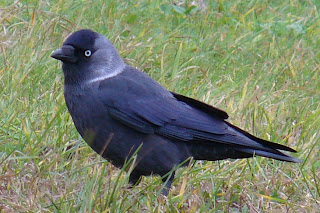 |
| Corvus monedula |
There are actually four different subspecies of Western Jackdaw. All of them differ by location and by their head and neck coloration. All four have dark grey/black bodies, but the size and lightness of the crown varies.
 |
| Western Jackdaws |
During the breeding season the birds pair up, and most of these couples will stay together throughout their lifetimes. Pairs will preen and groom each other to strengthen their bond. They build nests in crevasses, dropping sticks in order to make a platform (which can be problematic for chimneys). They lay 4-6 greenish-blue eggs at a time, and both parents incubate, defend, and care for their offspring.
Western Jackdaws are under no real conservation threat whatsoever. In fact, it is estimated that their global population is somewhere around 90,000,000 birds and rising. They are able to be hunted in several different countries throughout their range.
IUCN Status : Least Concern
Location : Europe, Asia, North Africa
Size : Length up to 15in (39cm)
Classification : Phylum : Chordata -- Class : Aves -- Order : Passeriformes
Family : Corvidae -- Genus : Corvus -- Species : C. monedula
Family : Corvidae -- Genus : Corvus -- Species : C. monedula
Comments
Post a Comment